A bit of history
So Agave is a plant that fascinated me from a very early age. I was very fortunate to be able to travel with family as a kid out to the desert Southwest and was absolutely fascinated by the idea of Agaves. And on one of those National Lampoon Vacation trips I was able to bring back some small plants, which I obviously killed. So it wasn't until many years later, when I was at NC State, the late J.C. Raulston had grown a couple of Agaves in the garden, and they did absolutely fine. For those that are native to the area and have been here a long time, you know that we actually do get cold. Last few years maybe not so much. For those that were here in 1984 -1985 we hit minus nine. So that was our really, really cold. All the stuff that people brought in, that lived through two or three mild Winters, died. As we got older and I began to travel, I was fortunate to go back to Mexico and instead of collecting at the bottom of the mountains, where most of the original Agaves had come from, because most of them were originally collected for glass houses in England and they didn't really care about the (winter) hardiness, instead we went collecting at 100 feet elevation and all the way up to the top of the mountain at 8 000 feet elevation and then into Arizona. Agaves are native from really Utah - South all the way into the Central America, so there's all kinds of hardiness ranges.

Agave albopilosa was discovered growing on a remote, nearly vertical, 3,500'-5,000' cliff in the mountains southwest of Monterrey in Nuevo Leon, Mexico.
But just because you've got a particular species, you need to know if it has a wide range, what that elevation is from. That really does matter. Which is why when you buy Agaves from us, we are pretty particular! We'll tell you "this Agave is a high elevation collection of plants". Some Agaves only grow in a very narrow climate range, and that matters to us because if it only grows at four thousand feet, and it doesn't grow at five, and it doesn't grow at three, then it is not going to make it here. Others may grow from 100 feet, as I mentioned, all the way up to 8 000 feet. And that is very important because there's only a certain number of Agaves that will tolerate the temperatures that we have here.
Agaves have been used for thousands of years. As Patrick will explain tomorrow, it is possibly the longest cultivated plant in humankind, which is pretty incredible. Despite what people think, humans were moving stuff around long before Columbus came here. Thousands of years before. Pretty much everybody in America came either across the Pacific Ocean or across the Atlantic Ocean. The first ones came across the Pacific Ocean by the Bering land bridge anywhere between 15 and 30 000 years ago, depending on which researcher you believe. They then went down and South and then came back up. A lot of the pre-Columbians from Mexico would take their favorite Agave that they used around their Village with them as they traveled, they would always take pieces. As they moved back up into what is now North America, they planted their Agaves. Their Agaves then hybridized with whatever was native. So it's very difficult now to know what constitutes a real wild species and what constitutes a pre-Columbian hybrid. As I hiked through Arizona mountains uh it's fascinating to look at plants that like "I don't recognize this!" That is what we call pre-Columbian hybrids. And there is a really neat book, if you're into something like that, called Chasing Centuries that came out last year. It really details a lot of that history and documents those populations, and a lot of those are in fairly mountainous regions and some have some potential winter hardiness here.
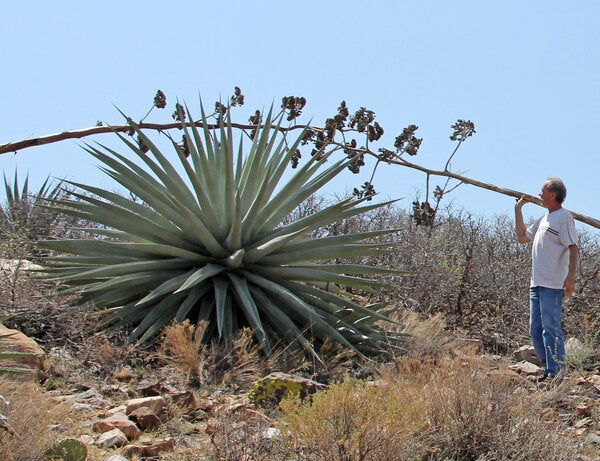
Agave chrysantha 'Pinal Giants' with Ron Parker, author of Chasing Centuries.
How to grow Agave in the Southeast
It's all about drainage
Agaves range from very large and the largest would be things like Agave americana, which is the one you generally see at the beach, which can easily be 7 foot tall and 12 foot across. And then there are other Agaves that are very small, that will never get more than a foot tall and a foot wide, so you can pretty much pick any size you want. The keys to growing them here: number one, they hate wet soil in the winter. They're from areas that are bone dry in the winter. We are generally not bone dry in the winter, so you have to find a way to make that soil well drained. Drainage is both internal and external. So when we build an Agave garden bed, we're looking at both. External drainage means "does the water run off?" So we just had a little shower andt this area is flat, you see the water is still here? You will see no water standing on the Agave berm because it's upright, so it runs off - great external drainage! Internal drainage is what's inside. So this material where we grow our Agaves is pretty much 50% a gravel product called PermaTill. So these beds are 50% PermaTill, 25% native soil which for us is sandy loam, 25% compost. That gives us good internal drainage. If you plant it straight in Raleigh red clay, your internal drainage is not going to be particularly good. So I would again mix in 50% PermaTill, 25% clay... that's fine, 25% compost. That's a mix we have found while experimenting for the last 35 years that works extremely well. So the internal drainage is very important.
The other way to make sure that your soil is dry in the wintertime is to plant a shrub on the North side that will suck the water out. That's a very common method, especially on the small Agaves, we always like to plant things that will not shade the plant, but will help pull that moisture out in the wintertime. You want things whose roots continue to be active. Evergreens are really nice. Deciduous plants will still pull some water, but you want things that will help keep that soil dry. As a general rule, we don't like to use organic mulches around the Agaves, they're just too prone to rot. We like to have either a bare soil, or a gravelly soil around there to control the rot. Because rain splashes dirt up on the leaves, and if that stays there and it's very damp, you can get some rotting spots. Now as much as they hate water in the wintertime they love water in the summer! If you have a large container, set it in a tray of water and let it stay waterlogged all summer long. That is contrary to everything you will read and everything you have ever been told. It is almost impossible to over water an Agave in the growing months. Now, you can keep the crown too wet, but if you water it from the bottom, it is almost impossible. Don't do that with the small plants, because they don't have the root system to stay that wet. But mature Agaves are absolutely incredible in that regard.
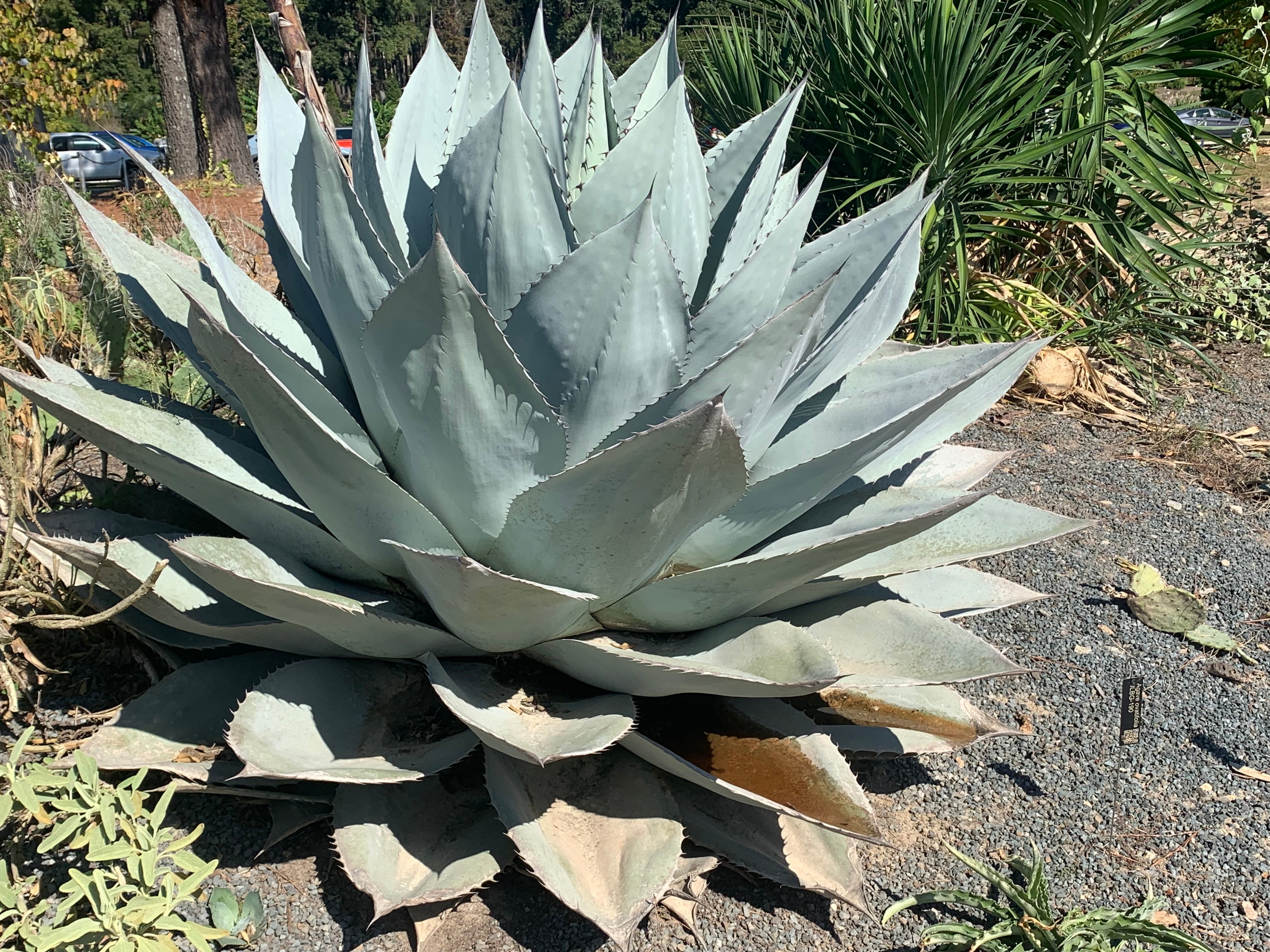
Agave ovatifolia is hardy to Zone 7a.
Planting season
Second key: you do not want to plant young Agave late in the year. Because Agaves have to be able to shed water in the wintertime, we don't recommend planting an Agave in this climate after really August. Anything after August, if you buy an Agave we encourage you to grow it as a container plant through the winter and then plant it out the following spring. Everything we grow is going to be in a quart pot, because we primarily ship Agave. So I would encourage you to put it in a larger pot. Agaves are one of those plants that absolutely grow to the container size. If you have it in the quart pot, you can keep it in there for years and it will stay small. If you put it in a three-gallon pot it will fill that pot in a matter of months. Agaves grow to the pot size. So if you get it in Fall, put it in a larger pot, you can keep it inside if you've got a bright sunny room, if not put in your garage for the Winter. You can keep it not much above freezing and, as long as you're not pushing it with water and fertilizer, it'll just sit there all winter in a sort of semi-dormant state and be absolutely fine. Agaves are one of the toughest plants known to man. As people who ship Agaves all over the world, we often get things hung up in customs disputes, etc... Agaves can sit in a box at a customs office for six months and be absolutely fine. There are very few plants that can tolerate that. So in terms of toughness they're pretty darn incredible. There are very few pests that bother them, certainly no deer that has good sense would try to eat an Agave. You'd have to be crazy to want to eat those. About the only thing I've ever seen eat them, are the jackrabbits of Texas and Arizona. Those things ain't right... I've seen them actually eat an Agave to the ground. So I can't imagine what their teeth look like, but I would certainly hate to encounter them.
Agave hybrids
So let's look at a few Agave. So what you see here, this berm, for those that are not regular, this berm has only been in for just over two years. This did not exist prior to that. Most of the perennials were planted from our quart size pots. These large Agaves were moved here from other areas. I would recommend, if you decide to move one, cut the spines off. Cut everything back except for the tip and then just dig it and move it. It's quite easy. Don't try to move it intact unless you've got a skid steer loader, they are very heavy. So these, for example, are some of our hybrids. Once we exhausted the species, we started hybridizing the Agave. See the ladder out there in the parking lot? So we got pollen off of one species and climb up to the next one and we create something brand new. We are able to almost design the Agaves for the size and the form we want. This is not something that really happened in the past. Here is an example of one of our hybrids. Agave x protifolia 'Green Sea Monster' is a cross between the Agave proto-americana, which is basically what you see mostly at the beach, and Agave ovatifolia. We crossed them looking to see how big can we get that. So that could get huge! That could get... we're anticipating mature size to be probably four foot tall by eight foot wide.

Agave x protifolia 'Green Sea Monster'
Preserving the genetics
Now in the wild, Agaves are called Century plants, because most of them flower in the wild once every hundred years and then they fall over dead. They live their entire life to have one giant horticultural orgasm and then they fall over dead. Now some of them offset! The offsets (the babies) are fine. It's like a Bromelia. But some of them never offset. So here's a hybrid for example of two non-offsetting species: Agave ovatifolia and Agave victoriae-reginae. So that one will grow its entire life and never put out a pup, and if we don't do something to force it to offset, that will flower and then die. And that's it, you've lost that clone. So we have over the years developed techniques to cause it to offset. So at the base of every leaf on every Agave, if you peel that down, there's a tiny little bud in there and that bud is told "do not grow" by the plant hormones. Those are called Auxins and they are generated from the tips here, and they send a signal "don't grow, don't grow, don't grow" so the only way to make those buds grow is to stop that signaling system. So we came up with a technique where we will actually take a drill and drill the center out. Just core it and drill all the way down all the way through the crown. And the plant looks like hell, it's not something to do if you want your plant to look nice. But if you don't want to lose it, then all of a sudden it'll start offsetting like crazy and then you can take those offsets and then you've got a lot of plants. We had to develop this technique because we were spending a lot of money on some new Agaves and we really didn't want to lose them once they flowered. Some people like solitary ones for design, some like offsetting.
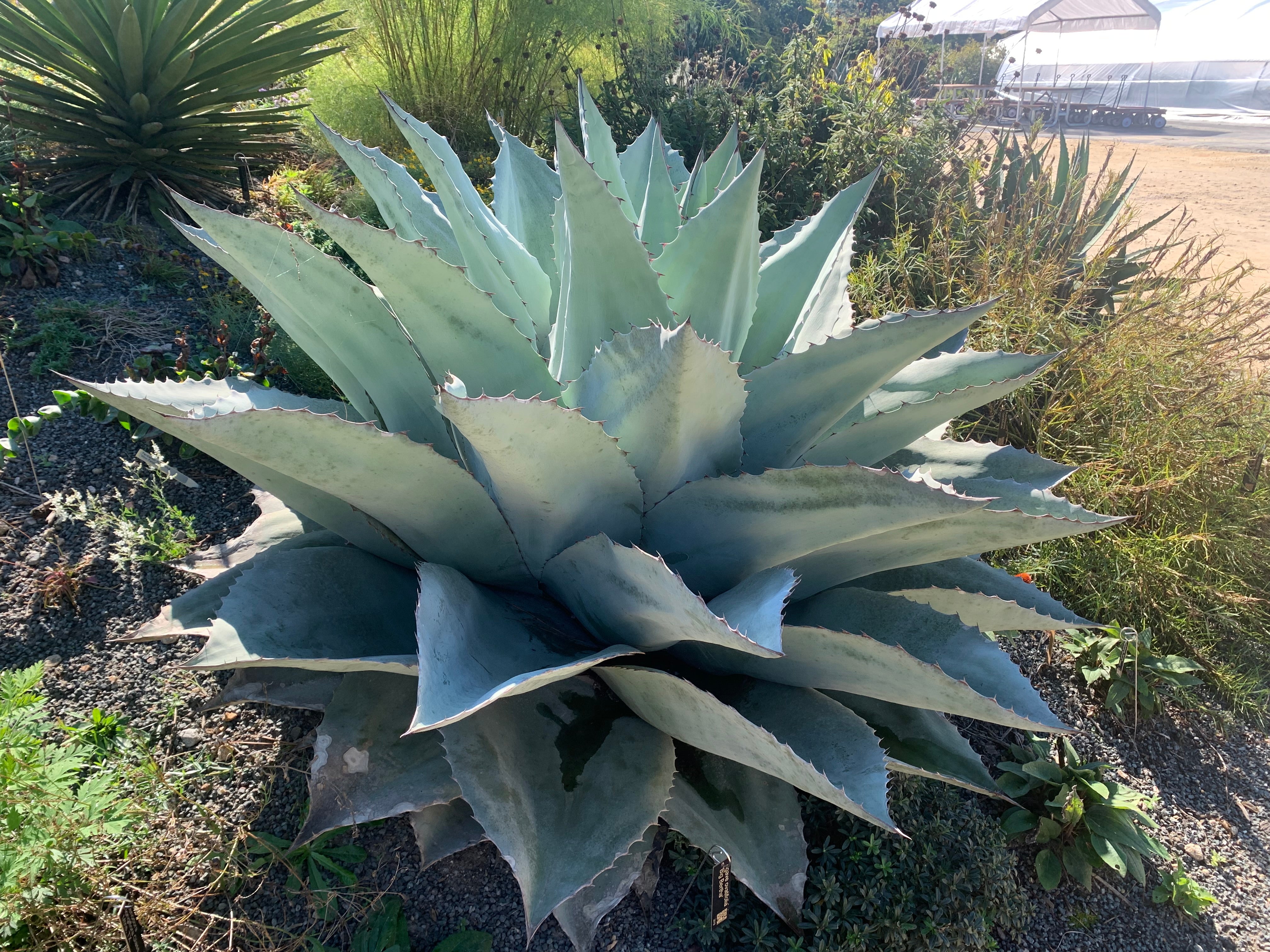
Agave ovatifolia 'Big Bertie'
Agave ovatifolia is one of the best Agaves for this region if you like a fairly large agave. And when I say large - three to four foot tall seven foot across. And those are always blue, it's a beautiful plant. So it's a fascinating plant and structurally there's really nothing like an Agave. It's incredibly architectural. Now again, when they flower some Agave species will flower in three to four years, some will flower in double that, some will flower in triple that. Agave flowering is based not on age but on size. Where these grow in the wild most of them are in the 8 to 12 inches of rain a year, 8 to 12 inches. We are four times that here, four to six times that! We can flower a typical Agave here in 12 to 15 years from seed, so that's pretty fast. Hybrids do things a bit different. Sometimes they develop what we call "blind shoots". They are not normal flower shoots that come from the center of the plant, they are smaller flower shoots come from the roots. We found that there's one parent - Agave pseudoferox, which is probably an old pre-Columbian hybrid, that sends off these blind shoots before the plant itself flowers. This particular Agave will probably flower next year and that flower spike will be closer to 20 feet. We love blind shoots because we don't need a ladder to breed them. Sometimes the plant sends up a half dozen of those, and it might start doing that five years before it is actually ready to flower. We think it is caused by a build up of hormones. Here's another Agave ovatifolia. We grew a lot from seeds because we wanted to see the diversity within the genus. So both of these are the same, this Agave ovatifolia 'Sitting Bull' is about... let's see, 2017. For those looking at our tags, below the QR code is the year that plant was put in the ground. That'll help give you an idea of the age. I think for six years old (2023) that's pretty big and it will be flowering somewhere within another one to seven years. You truly do not know! The idea that you can predict accurately is laughable... We've had some ovatifolias flower in seven years, some flower in fifteen years. Each individual is different. It's like humans, some people flower genetically very early and some are very late flowers. And plants are absolutely the same way.
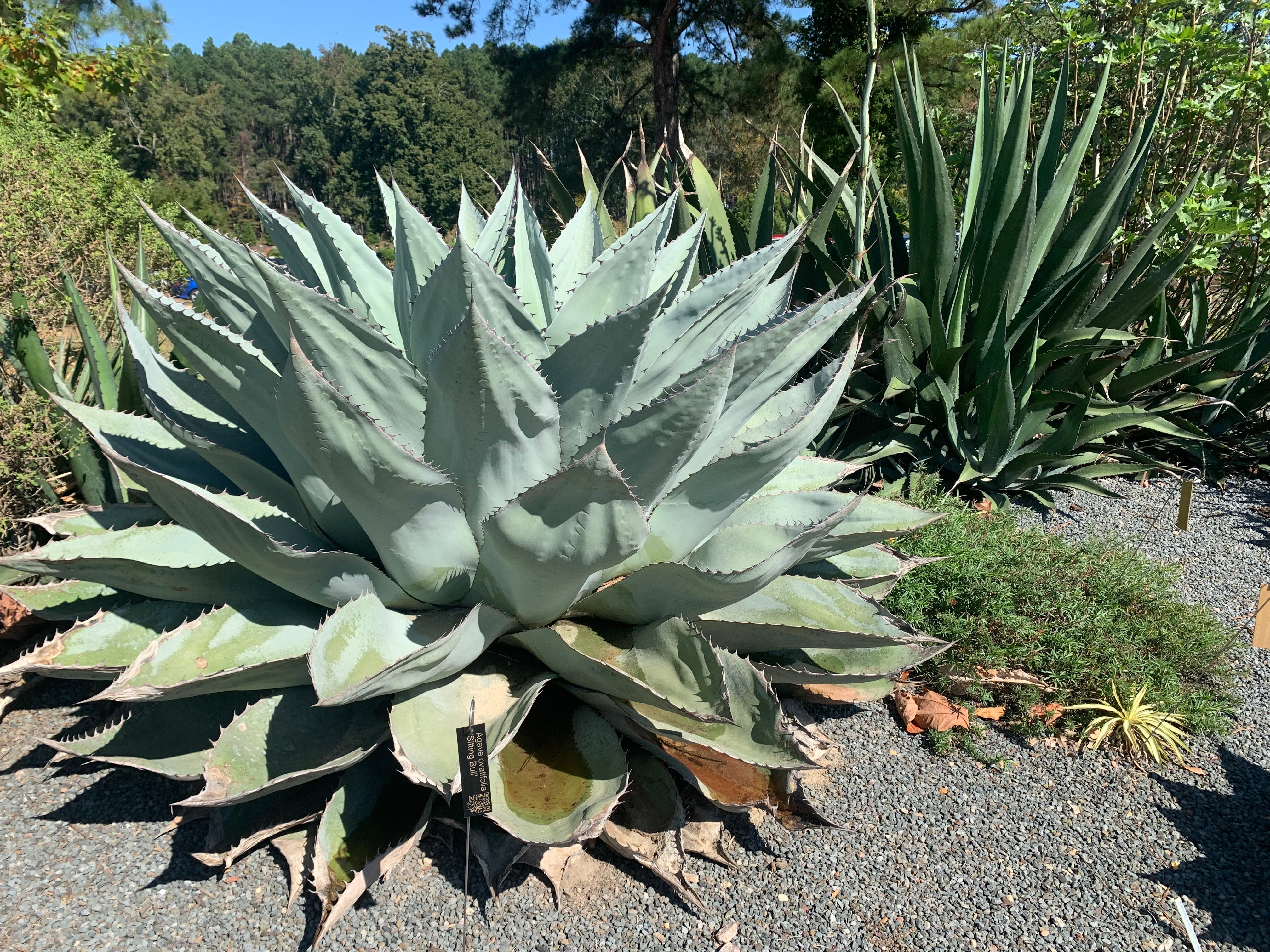
Agave ovatifolia 'Sitting Bull'
Questions and Answers
Okay, I think that's a lot of initial stuff. Anybody have any questions about the basics of growing Agaves?
Q: Practical question: where do you get the gravel?
Where do we get the gravel, okay! The gravel is a material that we like called PermaTill. There's only one place in the world that it is close enough to the surface to be mined and that is in Salisbury, North Carolina. Stalite Environmental produces it. You can buy it in bags or by the yard. Feel that... It feels like ground up pumice or lava rock. PermaTill is very permeable and it's full of air pockets. It is also incredibly nutritious. Normal gravel you think "that's not very nutritious" but this is loaded with nutrients. It also has a very high pH. In the wild, you see Agave in alkaline pH, generally a pH anywhere from seven to nine. But here we grow them in acidic soil, not low acidic, but in a pH of a six, six and a half Agaves are absolutely fine. PermaTill has a pH of 8-8.2.

PermaTill
Q: Do you think that's partly why you can get them to flower earlier?
It's all about the size. So good growing conditions. Yes, the soil mix is important, the moisture is important, the light is important - they've got to have full sun. The more light you give them the better. Now, in the wild, a lot of times you'll see Agaves in the shade when young. The way desert plants work, they've evolved to have what we call nurse plants. Agave start growing underneath something like a small tree when they are young, and then as they grow gradually crowd out the nurse plant, eventually killing it off and ending up in full sun. So they've got this incredible system in the wild for how they work.
Pro tips for winter survival: the bigger you can put a plant in the better. We plant everything the same size we sell, because that's just, that's what we do. Now if we plant a small plant, and we can see that we're having a cold winter and we put it in that summer, I will come out in the wintertime and get a cover. You know when you reheat your leftovers in a microwave oven, you have like a plastic dome that you put over it to keep the moisture in? We use those for Agaves. And there are some really good ones that are pretty tall. If we planted something very small, the first year we will put that cover over it during the winter time. Now most of those have a little turn knob, so that when you re-heat the leftovers you can open it to allow the steam out, you want to leave it open, you do not want to leave it closed. Because all you're trying to do, you're not trying to keep it warm, you're trying to keep the moisture off of it in the wintertime. If you keep the vent closed or if it is a solid lid, your plant will not survive because you'll cook it.
Q: If you had a solid lid could you just put a hole in it?
Yeah absolutely! Put several holes in it. All you're concerned with is keeping the moisture off of them in the wintertime. There was a very famous gardener in the mountains of North Carolina, Ev Whitmore, and first time I went to her garden back in the 70's, this is way on the other side of Asheville, she was growing all these Agaves. I was like: "How do you do this? How were you able to do this in the mountains in the winter time?" What she would do, she would put in four pieces of rebar around the plant and place a sheet of plexiglass over top. The sides were open, but she kept the moisture off of them and it was brilliant! Ev was growing Agave in a.. certainly a cold zone 6. It's all about the winter moisture. That is the key.
Q: Is it the winter moisture getting into the crown or is it getting to the roots?
Both. Crown is the is the worst problem, but yes those roots, absolutely. And that's why we tell people to plant things early in the year when it comes to Agave. Because then it'll have time to develop a crown to shed the water off. When it's really small, it doesn't shed the water away very well. The rain runs right down into the crown and then right down to the roots, and then they're rotted.
Q: In the past you mentioned planting on the slopes?
A: Yes! And that's what we talked about over here, it's that external drainage. That's why we like the slopes, they give you the external drainage. If you hike in the wild where Agaves grow in cold areas, you will never see an Agave growing on a flat. Never. They all grow on slopes. Now warm air, where it never freezes, yeah they don't care, they'll grow on a flat. I've seen them growing in seeps of water. But in cold areas you always see them on slopes. So it's that external drainage I mentioned. A lot of the soils out west have good internal drainage, but they don't always have good external drainage. So the slopes are absolutely the key. You can see, here's an example of something planted to help pull the water away - there is an Afghan fig, that's never going to get a lot taller and it doesn't take any sun away, but it's one of those many things that helps pull the moisture out. We've got cacti that help pull the moisture out. We've got a Leucophyllum over here that helps pull the moisture out. Not a requirement, but sometimes it's that extra piece that makes the difference between that plant surviving a really cold winter or not surviving a really cold winter.
Other questions?
Q: The plant that's over your head that is flowering, is that going to die?
A: Right here? Ahhh, that is a Yucca! That is first cousin to an Agave. So Agaves and Yuccas are both in the same family of asparagus. So asparagus you eat, these are all members of the asparagus family (Asparagaceae). When you see a new (flower) spike come out, like there's one down there coming out on one of the new Agaves, you can tell it looks just like an asparagus. So with Yuccas, there are monocarpic species, their rosettes die after flowering and there are Yuccas that are polycarpic, their rosettes don't. This is a polycarpic one. This one flowers and it just continues to grow. Whereas this Yucca here, this is the one almost everybody grows in their house, when its rosette flowers, that rosette dies. But, when it starts flowering, it sends up all these baby rosettes around it, so nobody ever notices.
Now what was really interesting with Agaves, back several years ago… Agaves have another close relative called Manfredas. And we have some on the back side over here. Manfredas are little native plants that are about this tall, they're succulent, they're rubbery, they have no spines, but they have purple spots on the leaves. And so we began the first program of crossing Agaves and Manfredas together, with two ideas. One, we thought Agaves have no purple in their background, so we crossed it and we were able to get purple spots into the Agaves. We also softened the spines and we got rid of the fact that they die after they flower. Because Manfredas don't. Manfredas they flower, next year they flower again, next year they flower again. All of our crosses, which we named Mangaves, and that's what you see here.
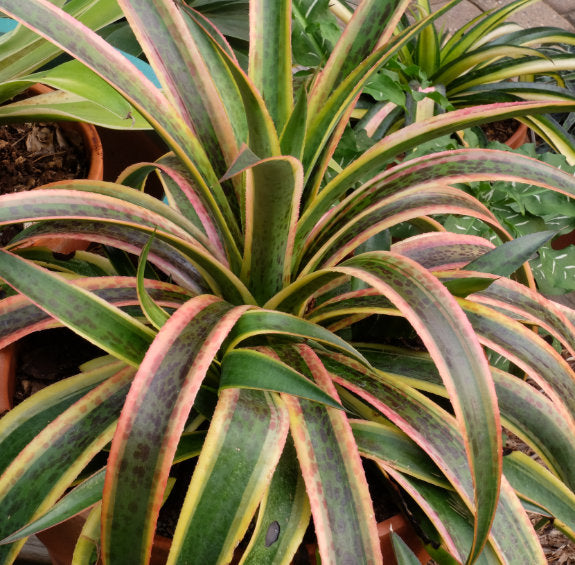
These are crosses between the two plants. 20 years ago none of these actually existed. We've been able to take those spots and concentrate them to the point that the plant actually looks purple in many cases or has all series of spots and colors and just crazy stuff. So that is a completely man-made everything here. It's a brand new man-made category. Most of these are tropical, and will not survive outside north of zone 9. We've got maybe eight that live outside in our zone 7b. Now when they flower outside, the spike is not as tall, it's sort of intermediate. It's probably an 8-to-10-foot spike. The next year the plant starts re-flushing from the ground and instead of one plant you'll have 15 or 20 of them. And then the next year it comes fully back. So it's lost the monocarpic "flower and die" trait in the first generation. Which is really cool. So there's some really neat things going on with Agaves... Until recentlty Agaves had pretty much been relegated to Southwest and we were certainly one of the very early places being inspired by the work of JC Raulston, who grew, like I said, a couple at the Arboretum, to really see what the possibilities are with the Agaves. Because we're all told they won't grow here, and it turns out they will grow fine if you put them in the right place and select the right one.
Q: Please repeat about Manfreda - does it die back in the winter?
A: Manfreda's.. there are some that are completely deciduous and there are some that are evergreen, they're not all the same. Which Manfreda parent you use decides if the resulting Mangave will die back or not. For those that don't know Manfredas, here are Manfredas. These are non-purple spotted ones, but these are Manfredas. That's a mature size on that Manfreda.
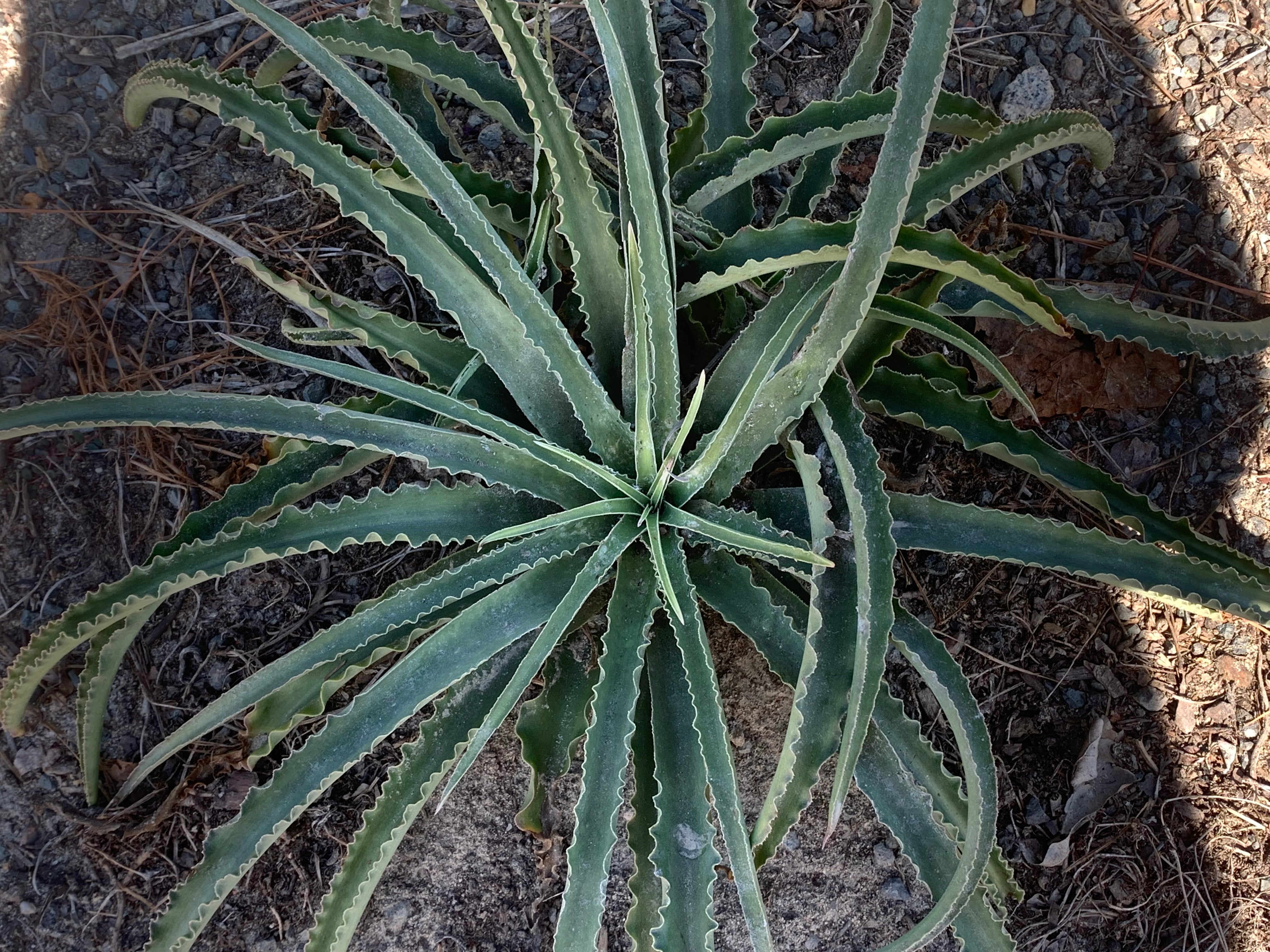
Manfreda undulata 'Crested Surf'
Here is a Mangave, this was crossed with an evergreen species of Manfreda and Agave ovatifolia, the big one there. That came through 11 degrees. Now what did it do? It stayed evergreen, but some of the old foliage got burned on it, so during the winter, late winter, it doesn't look great, but it's come right back. Here's another one right here... This is one of the main varieties called 'Whale Tale' that came through 11 degrees pretty good. It got, you can see here, a little bit of burn on here, a little bit of burn there. But they re-flushed so fast in spring, I think that's pretty amazing!
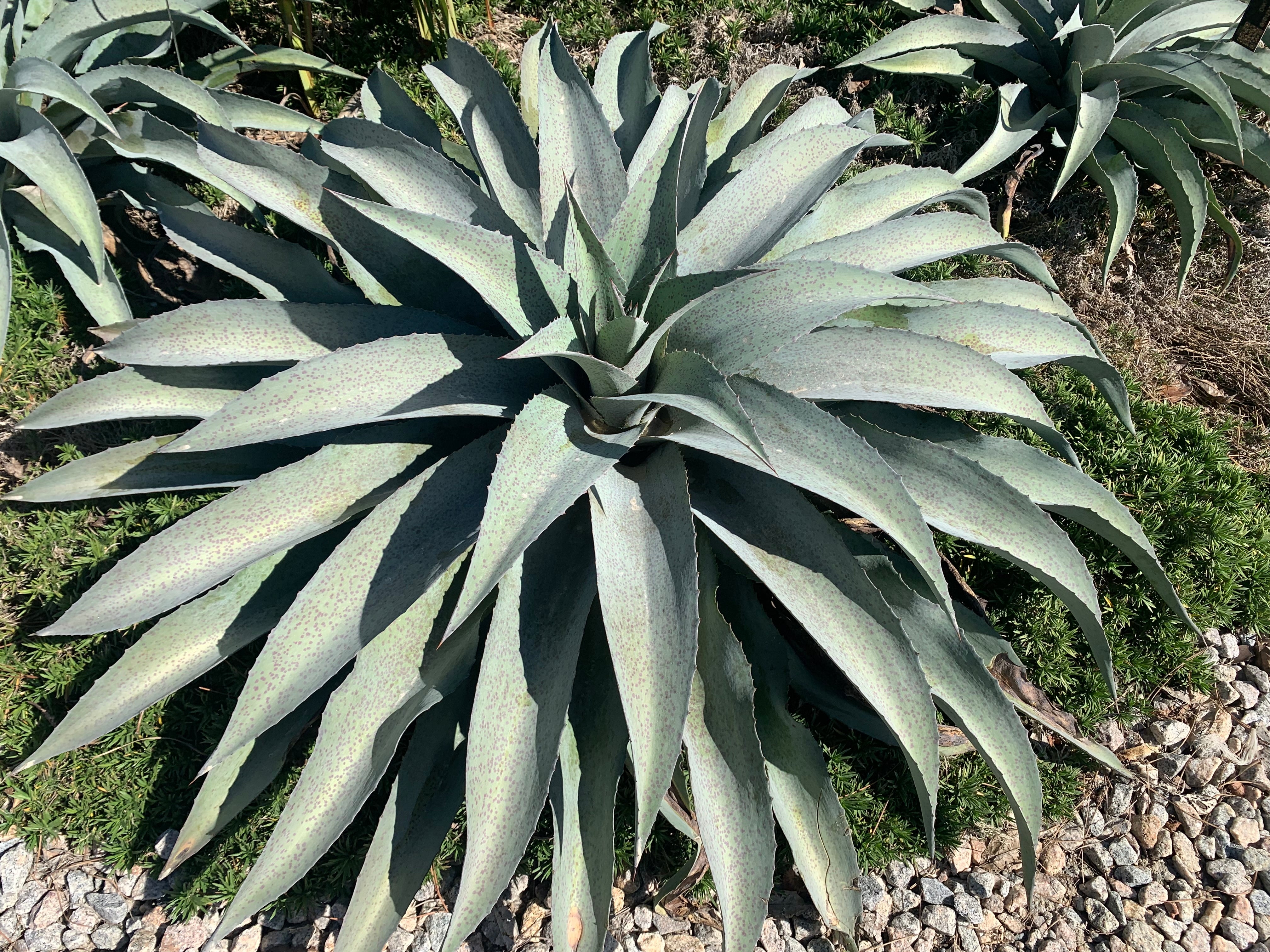
We're very young in breeding these. This is a very new project. We've got.. we've put in another 250 seedlings this year from our crosses last year. So where we can go with these is just.. we're not even close to (knowing).
Q: Can you trim away the dead part at any time?
A: Yeah, when we have time, it's just a matter of us getting around to it. We have so many of these, it takes us a while to get through the whole collection.
Q: I planted 'Bad Hair Day'
A: Yes! Uhuh?
Q: It flowered and the plant died. A couple of pups remained, but that was about it.
A: Yeah, so what it does, it will die back to the flower stem, to the base of the flower stem, and then it should re-flush from there. 'Bad Hair Day' is right on the edge of being hardy here, so I think that is probably more due to the winter. If you'd have had a milder winter, I think it would have re-flushed really nice. We lost our 'Bad Hair Day' which has not flowered, so 11 degrees is right at the edge of that. I think that's probably going to be a good 8B plant, we've had an 8A winter. Great question! Other questions?.. Cool, I hope you walk around and see a lot of the amazing Agaves that are here, and if you have the chance to come back tomorrow for Patrick's demo.. it's pretty crazy. You'll be amazed at the different types of thread that come out of Agave. He's got some thread already made and it's going to be a Martha Stewart type thing, it's really cool. Thank you all for coming! Thank you.

